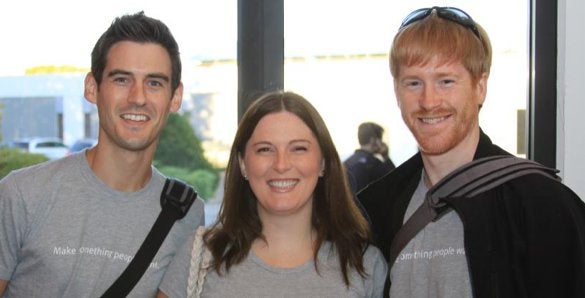Why Outsourcing Science May Be The Best Hope for Its Future

Share
No human is an island, so why should research scientists be any different? YCombinator backed startup, Science Exchange, helps researchers hire the expertise, equipment, and labor of other scientists from around the world. Think of Science Exchange as a curated Yellow Pages for the scientific community, a carefully vetted eBay-like system through which scientists can pay one another to perform the exact area of research in which they excel. When Dr. X gets a big grant to perform a genome study, she can use some of her cash to purchase the sequencing services of Dr. Y, leaving her plenty of time to focus on the juicier genetic questions she wants to explore. Science Exchange is collaboration powered by the free market, and it might just be the future of science.
Singularity Hub was fortunate enough to speak with Elizabeth Iorns and Dan Knox, two of the three cofounders of the company. Since their launch in August, startup Science Exchange has enabled research labs to accelerate the speed at which they perform science. How? Outsourcing. A dirty word among the Western public in today's economically downtrodden world, outsourcing in science isn't about losing jobs, it's about opening up access. As Iorns explained, not every scientist can afford to buy the most cutting edge super computer for simulations, or live near the largest radio telescope array, or invest their own time in mastering the latest microarray techniques. Which means that when their research requires equipment, access, or understanding they don't possess, scientists have to look elsewhere for help. In the past, this was done through a sort of collaborative barter system. I'll do the computer simulations for your atom cooling experiment if you find that spin coefficient for Strontium that I need for my latest paper. Now, Science Exchange is transforming that bartering into a real money-based transaction system. You need some help with your research? Science Exchange will find the scientific service providers that fit your specifications. The free market sets the prices, and scientists can get more done because they are focusing on the work they really want to do instead of trying to be a jack of all trades. Here's a promotional video to explain more:
Science Exchange does more than simply manage the marketplace for the purchase of research services, however. They vet providers, they (typically) handle the monetary transactions, they curate a rating system for each provider (and researcher), they help providers publicize their availability, and they even will work with researchers to track down the exact providers they'll need. For this, Knox says they charge a modest fee, anywhere up to 5% of the service cost (the higher the cost, the lower the rate). Yet Iorns points out that Science Exchange is actually saving researchers a lot of money because the company lets scientists select from service providers they may not have found on their own. The average price savings for Science Exchange users is a whopping 54%! Iorns says that the range of price for any given service is about 100%, meaning that the high end providers are usually charging twice the lowest end. With an average savings of about half, Iorns can conclude that “price is not the most important factor.” It's the price plus the reputation plus the availability that really determines each decision. In that way, all of the work Science Exchange is putting into their system is paying off – no wonder the company is starting to get noticed:
Looking at Science Exchange's limitations also gives some key insights into their success. First, Science Exchange creates each service provider (facility) page manually. That means the startup has to spend time and money to verify the services offered, the availability, the pricing, etc. Of course, that also means that Science Exchange really knows what each facility can provide and how each service may be best paired up with their users. (To date, there are more than 1000 “core facilities” in the database.) Second, even with extensive search features and filters, when a researcher finds a provider they want to hire, they can't simply click a button and order the work they need. Each transaction started on Science Exchange is really the beginning of a conversation between peers, with scientists on both sides discussing the needs and expectations for the work. However, that conversation really ensures that the work is a true scientific collaboration, albeit a paid one. Finally, Science Exchange is only going to be as comprehensive if both researchers and facilities find it attractive enough to join. To that end, it's always free to browse, and free for providers to list their services.
Knox and Iorns say that they are actively looking to expand their base of facilities (and researchers) in years ahead. Approximately 70% of the user base (facilities and buyers) of Science Exchange are in the United States, with about half the remainder in the EU, and strong presences in Australia and Asia. One of the big short term focuses of Science Exchange will be to expand the non-US numbers, transforming the startup into a truly global platform.
Be Part of the Future
Sign up to receive top stories about groundbreaking technologies and visionary thinkers from SingularityHub.


If Science Exchange is successful in that endeavor, it seems very likely that the company will have a major disruptive influence on the scientific community, and that is thrilling. The modern research ecosystem is broken: research takes months (if not years) to be published by peer review journals, prestige and grant money is disproportionately given to the very few researchers who publish in the most exclusive journals, and this “winner take all” reality for grant money means that scientists are incentivized not to share or collaborate. Many different companies and agencies are trying to change this system. Open science advocates want to allow researchers to share papers outside of the journal system, as seen with the very successful Academia.edu. Other companies work to replace journal reputation with a more broad based community reputation through tracking comments or citations.
Science Exchange is taking a third approach. By allowing researchers to easily outsource to other scientific experts and rate their experience, they are creating a sort of transactional peer review. Those scientists that receive the grant money spread it around by purchasing the expertise or equipment services of others. They also form de facto collaborations in the process. Reputation is tracked by both customer and provider satisfaction (yes, Science Exchange is concerned with provider satisfaction too). Where other organizations are trying to crack open the journal system to solve money distribution issues, Science Exchange is using money to solve some of the issues with the peer journal system. At least, that's how I see it.
Iorns and Knox certainly have their long term hopes for the company improving the way science is done, but you can tell they are still firmly focused on the short term. Expand the listing of providers, attract more researchers, continue with their globalization, provide an experience for all involved that is above reproach, save everyone money. They've got backing from YCombinator, at least another $1.5 million in invested capital, and a great deal of user satisfaction. With a beginning like this, Science Exchange is definitely going to grow quickly. As they do, they'll likely become one of the new influences that help renovate the old way of funding science. In that future, every scientist will be a scientific service provider. Which, if you really think about it, they already are.
[image and video credits: Science Exchange]
Sources: science exchange, elizabeth iorns, dan knox
Related Articles

Data Centers in Space: Will 2027 Really Be the Year AI Goes to Orbit?

New Gene Drive Stops the Spread of Malaria—Without Killing Any Mosquitoes

These Robots Are the Size of Single Cells and Cost Just a Penny Apiece
What we’re reading

